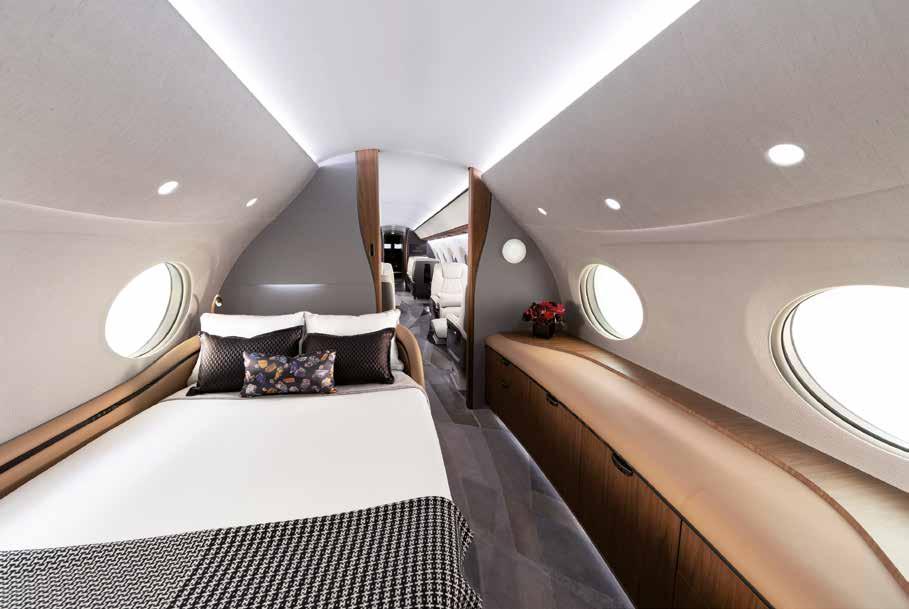
4 minute read
Fly: Game Changer
GAME CHANGER
The first G700s will be available in early 2022. Gulfstream is aiming high with a long-range business jet offering a wide range of interiors and refined avionics – and to combat jet lag, a smart lighting system that simulates the circadian rhythm
Advertisement

by Sergio Barlocchetti ph. Courtesy by Gulfstream

No other aircraft company embodies the business aeroplane philosophy more than Gulfstream, a company controlled by General Dynamics, which last October in Las Vegas presented its new flagship, the G700. The company has sought to raise the bar even higher than before. “The G700”, said company president Mike Burns, “Embodies the finest elements of our most cutting edge products to create a new, technologically-advanced aircraft that redefines the concepts of safety, speed, comfort and range. General Dynamics has invested a great deal in developing the Jetstream technologies and with a workforce of 18,000 spread across the world we are continuing our long tradition”. Its long range is the aircraft’s great selling point - 7,500 nautical miles (13,890km) at Mach 0.85, or 6,400 nautical miles (11.853km) at a speed of Mach 0.90. Not bad for machine with a maximum take-off weight of 48.8 tonnes, over 22 of which may be accounted for by fuel.
The cabin is the wider and longer super-midsize category, with five living areas, a spacious galley, crew compartment, conference and dining room and a bedroom with shower. Already holder of the record for window size, on this jet Gulfstream has included twenty windows and has made further improvements to the climatization system, providing the lowest cabin pressure and noise levels in the sector. One other feature really stands out, though – to help prevent jet lag after the long flights a circadian lighting system has been installed to recreate dawn and sunset and prepare passengers for new time zones. The lighting panels comprise thousands of white and amber LEDs, reproducing natural light. Interestingly, while other companies seek to develop designs that help passengers forget they are on board an aircraft, Gulfstream succeeds in creating lovely interiors that never seek to fool passengers into thinking they are anywhere but on an aircraft, making the flight a unique, unforgettable experience. Guests can remain fully in touch
The wings with new-generation winglets and complex moving surfaces enable the plane to operate from relatively short runways. The cabin (opening) can host up to 19 passengers or can be laid out in a series of zones including galley, bedroom (opposite page) and dining or meeting area

with their professional and social life all the while through latest-generation satellite connectivity. The cabin is 191 cm high, 2.5 metres wide and more than 17 metres long in a fuselage with a total length of over 33 metres. The aircraft’s maximum height is 8 metres. The demanding laws of aerodynamics apply to all aircraft builders, and larger fuselage sections end up by adding weight to the aircraft and requiring greater power. But there’s no need to worry about the interior space, which if kitted out with the maximum number of seats can accommodate 19 passengers in comfort, while the most restful configuration provides 10 normal-size beds. In the cockpit, the pilots work with the Symmetry Flight Deck system, entirely touch screen and equipped with Predictive Landing Performance System functions that provide an unprecedently complete information for managing approach, landing and take-off. Not to mention, of course, the synthetic vision provided by the Enhanced Flight & Synthetic Vision system on the dual head-up display. A pair of Royce Pearl 700 engines generate 18,250 pounds of thrust with a power-weight ratio 12% better than all other engines in this power band. Remaining faithful to its traditions, Gulfstream has given its G700 a wing with classic geometry and a span of 31.39 metres. The wings feature a new type of winglet and complex moving surfaces, so despite its dimensions and weight the aircraft can operate from relatively short runways and reach high altitudes. Five aircraft are being used for trials, and when successfully completed certification will be granted by the end of 2021. The first models will be delivered to clients the following year. The first of an initial series of ten examples will join the Qatar Airways fleet for the Qatar Executive service. The official price will be around 75 million dollars, a cost that seems to be a psychological barrier in the business jet market. It’s a few million more than its direct rival, the Bombardier Global 7500, but if you’re looking for greater cabin comfort and speed the higher cost will be absorbed during the G700’s operational life. www.gulfstream.com










